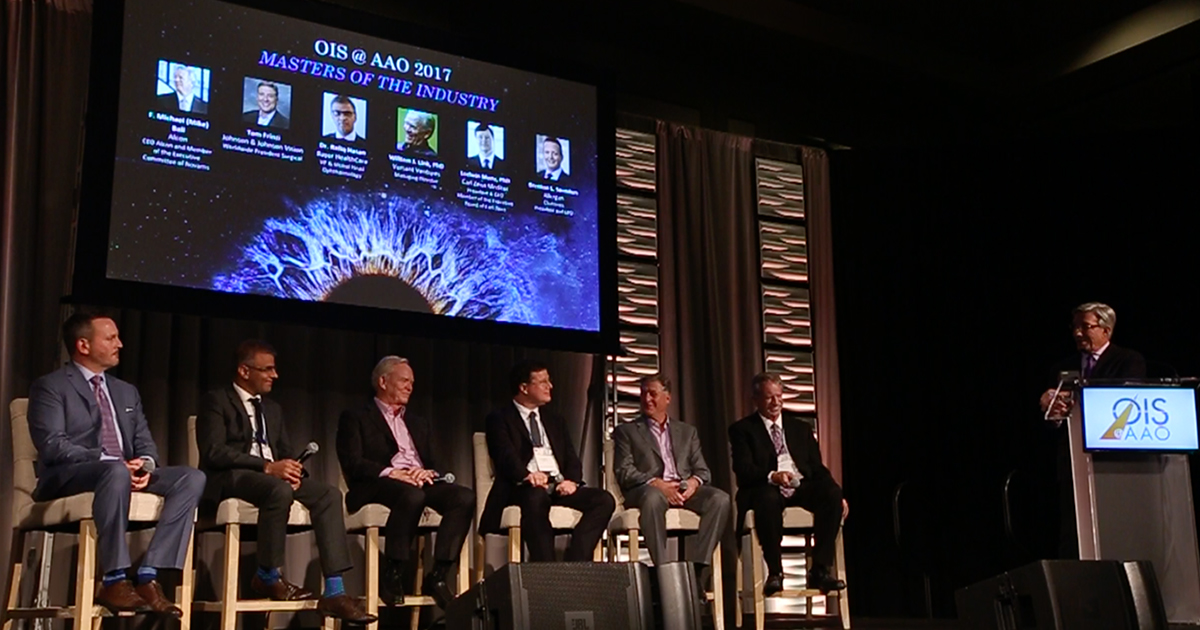Masters of Industry: Digitization, Millennials, and the Future of Device and Pharma

The forces driving ophthalmic innovation are digitization and demographics, namely in the emergence of millennials, and how the major players in ophthalmology respond to those forces will determine their future success, said participants in the Masters of the Industry session at OIS@AAO 2017.
Moderator Jim Mazzo, global president of ophthalmic devices for Carl Zeiss Meditec AG, noted that in the first six months of 2017, $3.5 billion had been invested in the digitization of healthcare, and millennials now number 75 million in the US. “They’re two times more likely to adopt technology, but they do their homework and they ask a lot of questions,” Mazzo said.
The Digital Impact
Allergan chairman, president, and CEO Brent Saunders talked about how the digital wave is revolutionizing pharma R&D. “Even in clinical studies, we’re going to start utilizing digital wearable technologies to look at lifestyle metrics and other quality-of-life metrics that we’ll use with payers,” he said. “And also, I think we’ll be able to use digital technologies to help with FDA-specified endpoints.” On the commercial end, he foresees using digital technology to build markets. “I suspect the millennials will consume more in digital,” he commented.
Digital technology will change how pharma and device companies interact with physicians and consumers, particularly through remote monitoring of patients, said Rafiq Hasan, MBBS, VP and global head of ophthalmology for Bayer. “I think it’s going to change the way we administer therapeutics as well,” he added.
William J. Link, PhD, managing director of Versant Ventures, said digital technology will usher an “intimate connection” between patients, providers, and pharma and device companies, “because now we can monitor and get feedback immediately on changes that historically took a symptom or a sign to bring the patient into the office.” He continued, “We might be able to monitor that on a day-by-day, hour-by-hour basis.”
Technology had focused on generating patient data, but the digitization of healthcare is changing that, said Ludwin Monz, PhD, president and CEO of Carl Zeiss Meditec. “With digital technology it will be about the interpretation of this data,” he explained. “The other aspect is workflows. When it comes to therapies, it’s about bringing together preoperative diagnostics, preoperative data, and the patient in the operating room.”
Digital technology will also foster interconnectivity, said Tom Frinzi, worldwide president, surgical, of Johnson & Johnson Vision. “That information is reportable from facility to facility, then facility to the patient at home for reasons of monitoring as well as treating,” he stated. “When we get that closed loop, it’s going to transform the way we think about our world today.”
But millennials have high expectations for digital technology that industry must meet, said Alcon CEO Michael Ball. “They want this work-life balance,” he noted. “They need data, they’re used to data, they’re comfortable with data, and we as an industry are going to have to get with it in terms of data and our technology,” Ball said. “They don’t like clunky stuff; they like smooth stuff.”
Millennials in the Clinic
As Mazzo pointed out, ophthalmic companies have to do more than cater to the patient needs of millennials; they’ll have to deal with millennials as physicians and end users of their products. He asked the panel how they would address the millennial eye doctor.
“I would call them the digital natives,” said Dr. Monz of Carl Zeiss Meditec. “They’ve learned to use digital technologies, so the expectation is that we as industry offer tools and offer data sources that allow them to do this. That will be the challenge. The opportunity is there, but we will need more and more to come up with products that address this need.”
The interplay between artificial intelligence (AI), apps, and pharmaceuticals will become more important, stated Dr. Hasan of Bayer. “Being able to deliver an AI-based algorithm that actually defines what sort of therapeutic question they need may be just as important as providing the product alongside that,” he said. “We’re going to have to get a lot smarter in terms of how we actually leverage those different technologies.”
Allergan’s Saunders said that pharma and device companies may need to reach millennial providers through platforms such as Instagram and Snapchat. “We’re going to have to use much more data to show very clearly why a device, diagnostic, or drug is right for a certain patient population,” he stressed. “We’ve always done that, but I think it’s going to become more important to have that data, and it has to be compellingly clear.”
Alcon’s Ball noted how the likes of Amazon, Google, and Facebook have upended other industries. “We as an industry have to be very cognizant of what’s going on in the environment around us and not think that the way we practice medicine today is the way we’ll be practicing 10 years from now,” he said.
Added J&J’s Frinzi, “The millennial eye doctor today cares more about work-life balance than maybe their predecessors did, and that changes a little bit about how they practice and how we relate to them. You combine that phenomenon with the practice consolidation that’s happening, particularly in the US around private equity, and you have a very challenging ecosystem that ultimately we all have to figure out how to appeal to in a more effective way.”
